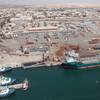Through a series of coincidental meetings, Southeastern New England Shipbuilding Corporation (SENESCO) was formed by seven individuals with different, unique backgrounds. Although only three of the original seven founders are still involved with the company, the focus remains the same. In fact, the young company is expecting its first delivery this autumn.
According to Richard Carpenter, president and director of the company, the seven founders joined up during the winter months of 1993 and 1994.
"The driving engine was a series of conferences called 'Navigating Beyond 94,'" he says. "It was held in New England, and asked the question "where is the maritime industry going in the next five or six years?" One of our founders, John Hopkinson, who ran his own naval architecture firm, attended the conference, and came up with the initial idea for a shipyard."
Carpenter, who had 30 years experience as a practicing attorney, concentrating on maritime, corporate and banking law, with experience in business, government and legal matters, became involved when Hopkinson had some papers to be notarized. An attorney-client relationship developed, and ultimately, Hopkinson invited Carpenter into the fold.
Around the same time, Carpenter says, Robert Guastini, the company's vice-president, COO, director, befriended Laurence Gebhardt, vice-president: human and organization development, director. Interestingly, the two met while Gebhardt was looking for his daughter's lost dog. The two began talking, and found similar backgrounds, in that Guastini had 32 years of management and technical experience in shipyard technology and development with General Dynamics, while Gebhardt had 26 years of U.S. Navy experience in submarine command, at-sea operations, shipyard maintenance and repairs.
Gebhardt was retired, but had recently been published on articles relating to quality, productivity and teamwork.
Hopkinson, Guastini and Gebhardt met at a seminar on how to revitalize manufacturing in Rhode Island. A group of manufacturing companies - all unrelated in industry - attended the seminar. The three began talking, and found they each had the same question: How to revitalize shipbuilding in the U.S.? How can we maximize what's left over from downsizing?
The SENESCO facilities are located at Quonset Point, a 3,000-acre industrial port on Narragansett Bay. The company's property was acquired in two portions - each of which had been previously been leased by Electric Boat from the state of Rhode Island.
The first site, dubbed SeaPlane Hanger 1, featured 18 acres of property, with a 106,000-sq.-ft. manufacturing building. Electric Boat had used the facility to manufacture decks. A few years later, SeaPlane Hanger 2 became available, bringing the company another seven acres and a second manufacturing building, comprising 111,000-sq.-ft.
In total, the company's 25 acre site includes two industrial buildings enclosing 217,000 sq.-ft. of manufacturing floor, 500 welding stations and production machines, 11 overhead heavy-duty cranes, 19 acres of reinforced concrete, suitable for heavy manufacturing layout, and 537 ft. of waterfront suitable for barge and shallow draft vessel launchings.
The waterfront capacity is limited to tugs and small ferries, with a length limit of 250-400 ft., and a tonnage limit of 1,200 dwt. Some dredging needs to be done, to bring the depth to approximately 22 ft., and SENESCO is in the process of working through the USACE and the local Department of Environmental Management for that dredging work.
Essentialy, however, the company's focus will be on building barges for lake, coastal or full ocean service. Although the company must employ some alternative methods of launching, currently; they are landing contracts. The first - for a small barge with an option for two more - is scheduled for delivery later this fall.
Eventually, the company would like to expand its portfolio to include supply boats and tugboats, shallow-draft ocean-going vessels, offshore platforms, buoy systems and pontoons. Plans are for the entire range of vessels to be available by the beginning of the year 2000.
"Right now, though," says Carpenter, "we're building simple barges, flat-plate ferry boats, crewboats, small passenger vessel launches. We would like to be considered by the East Coast operators as a viable alternative for tugs, ferries, barge and to familiarize them to who and what we are. Recently, we've been paying face-to-face visits with various operators along the East Coast."
Currently, the company boasts a small, efficient workforce, of approximately 28 laborers, but Carpenter says the company's finance level will ultimately allow them to field a force of approximately 250 people.
One of the early issues the company had during startup, was a credibility problem with the current landlord, which was the state of Rhode Island. However, Carpenter says, the director of the Economic Development Corporation, John Swen, "decided he'd give us a shot at developing the place. With a small business revolving loan, which was matched by our present investor, we put together a business plan.
"When we started, we had a Maritech grant, which was aimed toward commercial projects," says Carpenter. "Our presentation to Maritech to receive the grant covered new ship design and manufacturing techniques. Our general belief was there was a way of standardizing ship design and construction. And with the labor force here, many of which were laid off from Electric Boat and Derecktor Shipyard, when each closed its Rhode Island facility, many are familiar with modular construction. The idea of putting together packages is not foreign to our workforc."
Additionally, the company's lease is highly attractive: There are three conditions to be met to ensure renewal.
"First, we had to raise a private investment," says Carpenter. "We did that. Then, we had to meet an employment goal, and we're very optimistic that will be reached. Lastly, we had to commit to renovating and making refurbishments to the facility, which we are also currently doing. Our workload is not a condition, however. We do not have to generate a certain amount of business in our early stages to retain the lease. That's what makes it so appealing."
Although four of the original seven founders are no longer affiliated with the company, SENESCO has managed to entice some reputable industry personalities
Robert Homan, the company's CEO, spent 38 years in the maritime industry, holding the position of senior vice-president and general manager for Crowley Maritime Corporation.
Robert Jarvis, the shipyard general manager, possesses more than 30 years of experience in shipbuilding. Jarvis is the former vice-president of new construction for Service Marine (Morgan City, La.). Also, Jarvis held positions of general manager for McDermott's shipyard division (also in Morgan City); president of Boston Graving Dock; Project Manager for St. John Shipbuilding, in Canada; and general manager for R.E. Derecktor's Rhode Island facility.
Sponsored Content
Lower carbon intensity fuels to support your operations

Subscribe for
Maritime Reporter E-News
Maritime Reporter E-News is the maritime industry's largest circulation and most authoritative ENews Service, delivered to your Email five times per week










